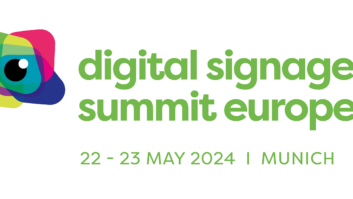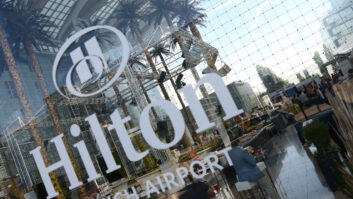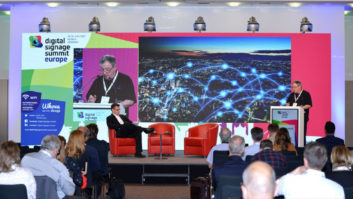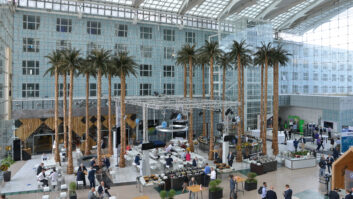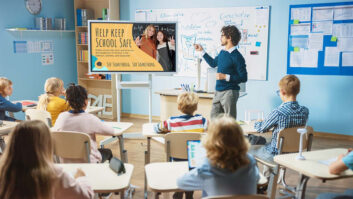Paddy Baker reports from the 2015 Digital Signage Summit Europe, which drew a very healthy attendance in Munich last week.
The ninth edition of the OVAB Digital Signage Summit Europe took place on 10 and 11 September in Munich. The first fruit of a joint venture between invidis consulting and Integrated Systems Events, the conference attracted some 470 delegates. The event’s unique selling point is that it is the only conference to cover both technology (digital signage) and market (digital-out-of-home) topics.
The first day saw a digital signage tour of Munich in the afternoon, followed in the evening by a visit to Weihenstephan, the world’s oldest brewery, where the Digital Signage Awards were presented to the best-performing display, software and integration companies during 2014.
Networking opportunities were plentiful during the conference – not simply by the provision of long breaks during the day, but also through a ‘matchmaking’ service by which delegates could book appointments.
The conference proper began the next morning. Florian Rotberg and Oliver Schwede outlined some of the key themes of the conference in their keynote presentation, ’Digital Signage 2020 – the shifting balance of power’. They discussed a number of drivers from within the industry, from the customer side and also on the DOOH landscape.
Disruptions to the industry included the decision by German outdoor agency Ströer Media to used Ayuda’s ERP system in place of a combination of ERP and CMS – taking a potential 5,000 software licenses off the market; the advent of Adobe Experience manager and also the licence-free Google Chrome Digital Signage; and a global content partnership between Samsung and digital publishing house Axel Springer, which could potentially extend to digital signage.
Freelance contractor Giovanni Flore presented two major Benetton digital signage campaigns he was involved with in recent years, one in-store, the other which used shop windows to show engaging, quirky, sometimes interactive content. “A brand cannot involve its customers with commercial content only,” he opined.
Flore then took part in a panel debating ‘The evolution of digital signage – from instore TV to customer engagement’. Here, Damian Rodgett of Pilot Screentime pointed out that two of the most sought-after deliverables from signage projects are engagement and reach, but that these are generally “polar opposites” – you can either deeply engage with a limited number of people, or reach a large number of people but in a less engaging way. He added that signage technology was now sufficiently mature so that effective point-of-sale campaigns are no longer restricted to global brands: they can work for national or even regional brands, which wasn’t the case two years ago.
A number of case studies were presented during the day, most of which were talking about increasing customer engagement rather than directly driving sales. An exception was the case study from the FCBarcelona digital megastore, presented by Daniel Urruchua of TMFactory. Here an in-store screen-based system allowed customers to choose the size and style of football shirt they wanted, and to add the name to be printed on the back. This was no small software feat, he pointed out: the software had to be “like an orchestra director”, connecting digital signage, ERP, payment, printing and RFID systems.
Roland Grassberger of Grassfish (which last year, it was revealed, toppled Scala from the top position as top DS software vendor in the DACH region) presented a case study of system at the DHL Innoviation Centre, which cleverly uses standard digital sigage software, dynamic device control through trigger points in playlists, and integration with the AV and lighting system, to create a showroom experience that can be customised by non-technical staff to suit the interests and industry of corporate visitors.
Felix Reinshagen of NavVis (a company spun out of a research project at TU Munich) and Thomas Kallmayer of Munich Airport presented a mapping and AR solution for Munich Airport which compares live video from passengers’ phones with a detailed pictorial model of the airport as a very accurate location finder. As they walk through the airport and into shops, they are presented with information on points of interest, which they can search through in more detail – for instance, individual shops’ stocklists.
A discussion on 4K in digital signage produced some contrasting opinions. Stefan Knoke of Seen Media pointed out that, while there were obvious cost implications of moving to the better quality that 4K provides, 90% of customers may not notice the difference. Jeff Hastings of Brightsign countered that 4K had brought “a whole new wave of clients”, particularly from the world of fashion, who previously wouldn’t have considered digital signage because the image quality wasn’t good enough.
In addition to the conference sessions, there was an exhibition area where more than 20 of the sponsoring companies had stands. This remained busy even during the sessions – one exhibitor remarked that he had barely had the chance to visit any of the sessions because of the level of interest on its stand.
On this showing, the Digital Signage Summit Europe looks like going from strength to strength. The model is also being rolled out in other territories, with the Digital Signage Summit Russia taking place on 28-29 October in Moscow, and Digital Signage Summit MENA being held on 16 November in Dubai.
